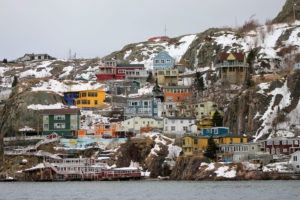I love when guests ask about the brightly painted homes they see in St. John’s and how we came to choose such a wonderful palette of colours.
Years ago we had no historical references to explain our preference for paint, so we used our heads and applied some good old fashioned Newfoundland logic to create anecdotes that were every bit as colourful as the homes themselves.
I usually start my interpretation with an explanation of the Newfoundlander’s fierce, independent nature and the need to distinguish their home from all the neighbours in their row.
I then remind them of our many varied weather conditions and the desire to provide a bright spot in what might otherwise appear to be a stark, old day.
Some have suggested that a Newfoundlander’s boat took priority over the house and after coating the hull and gunnels, the leftovers were blended to create a bizarre mixture for their home siding.
My brother David (the lawyer) always said it had more to do with George Street and the beacon it became after a hard night of drinking, ensuring you didn’t end up in a neighbour’s bed!
This explanation works well, always evoking smiles, laughter, and an appreciative nod for our ‘Newfoundland Humour’.
Job well done!
Yes, until you really get to thinking about it – for while there are elements of truth in all of this, a little research and sounder reasoning would suggest a slightly different, more realistic story.
Years ago we wouldn’t have access to such brilliant paints. These colours simply didn’t exist before modern chemistry was applied to paint manufacturing. Not to mention the staunch, almost puritan nature of old St. John’s and the social disdain this might evoke in neighbors who could potentially view such a display of vanity as an expression of excess and unwanted happiness.
But by the time these wonderful paints became available, there were very few homeowners left in the downtown core. Modern transportation and a reduced reliance on the sea allowed government and business to grow the city beyond the harbour’s cirque. A trend that was further fortified by OPEC’s “energy crisis” and a ‘disco era’ that demanded more stylish and efficient homes, built in shiny, new suburban neighbourhoods . Thus, like many other large municipalities throughout North America, the inner city of St. John’s was gutted of its populous in the 1970’s.
As downtown property values plummeted, an opportunity arose for those groups who exhibited lower incomes, were especially attached to the historic community and preferred to live communally – the arts community.
Which is most appropriate since this is a group who, as our original interpretations would suggest; are truly independent, creative by nature, enjoy a good party, have little regard for what others might think or say, and would certainly appreciate a sale on mismatched, off tint paint mixtures.
I know this from personal experience for my very first home was located on Gower Street; purchased for the princely sum of $68,000 in 1998 – a price that reflected the many renovations required, including an exterior paint job. The very day the house sale “closed”, I booted it down over the hill to Templeton’s Hardware to purchase 5 gallons of latex from the discount shelves in the back warehouse – yes, a sale on some off-tint blue that resulted in the craziest texture of mauve imaginable.
We had a lot of fun in that “camp” – dubbed by my father on his first visit, stating, “This is not a house – this is a camp!”. We edited two Boondockers videos there, recorded music, worked with well-known actors Greg Malone, Kent Browne and Pat Dunne, wrote stories, played music, sang and danced. We were indeed, active participants in the St. John’s arts scene.
We were also quite independent, fiercely so, in every way imaginable. And spent many a night on George Street with a subsequent walk home, searching blindly for our spot on the hill.
So really, no matter how you explain the beauty of downtown St. John’s, it’s going to make for a great yarn. And as our Grandfather often reminded us – “Don’t ever let “facts” get in the way of a good story!”





